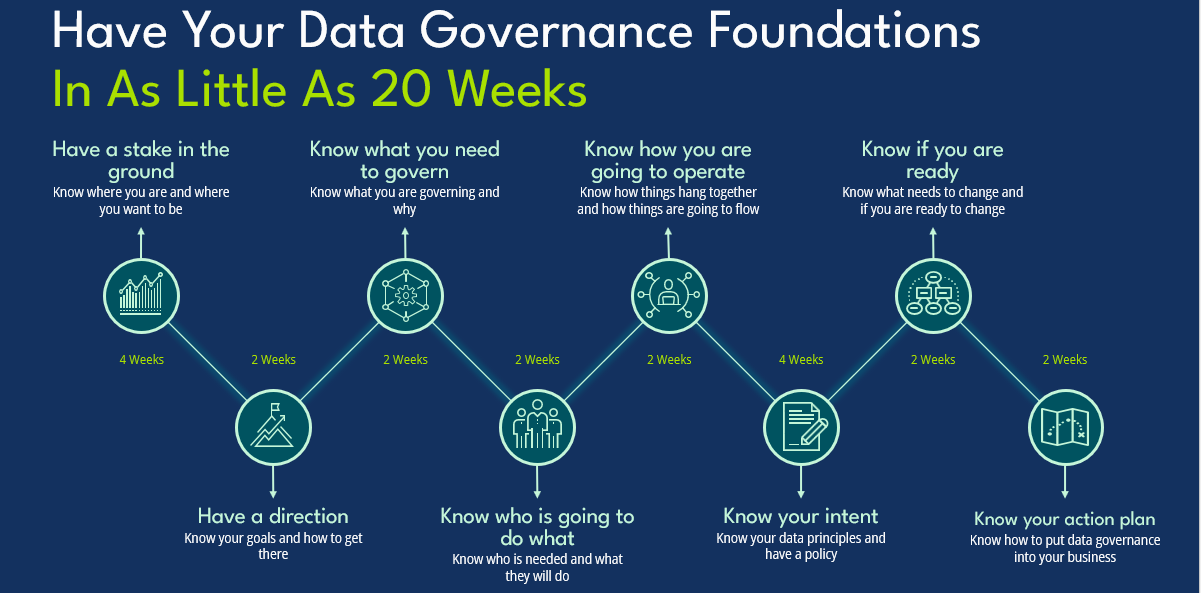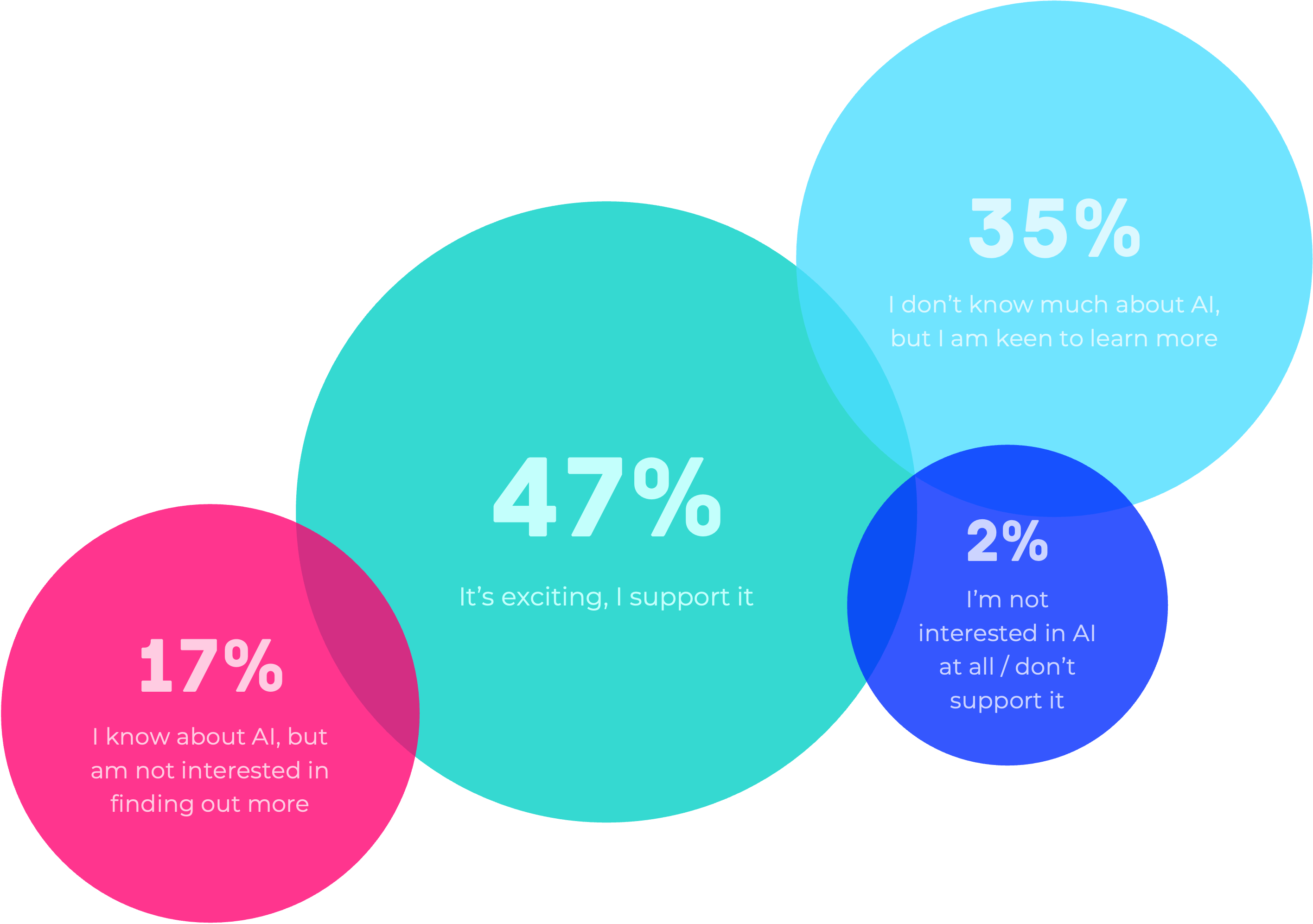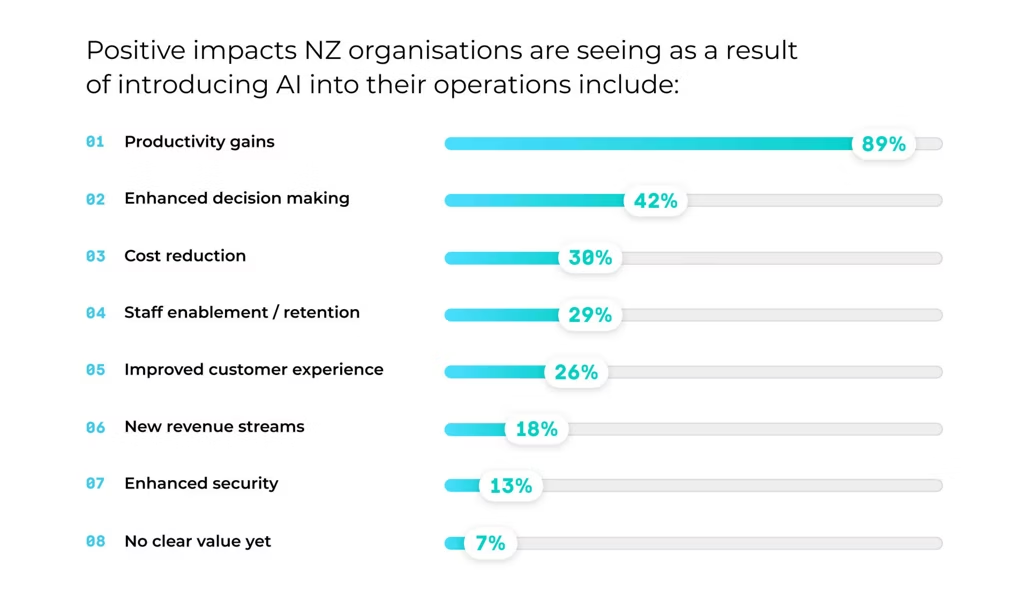Why NZ companies are hitting roadblocks in scaling AI and what to do about it

NZ businesses are embracing AI but struggling to scale it. The key is shifting from pilots to strategy by building solid data foundations, clear governance, and leadership buy-in to turn AI from an experiment into a real competitive edge.

The momentum behind artificial intelligence (AI) in New Zealand is real. According to recent research from Datacom, 87 % of organisations in New Zealand are using some form of AI — up from just 48 % two years ago. Moreover, of those using AI, 88 % report a positive impact on their operations.
Yet despite the strong uptake, only 12 % of companies say they have rolled AI out across the entire business.In other words: many organisations are experimenting, piloting, or using AI in pockets — but far fewer are seeing full-scale transformation.
In this blog post I’ll explore the key roadblocks NZ companies face when scaling AI, and offer practical recommendations on how to move from pilot to enterprise-wide delivery.
1. The scaling gap: where NZ stands
Adoption has surged: 87 % of NZ organisations now using some form of AI.
Strong reported benefits: e.g., Productivity gains, improved decision-making, cost-savings.
But scaling remains rare: Only ~12 % have enterprise-wide deployment.
Government strategy in place: The NZ Government’s AI Strategy states that future growth depends less on creating foundational AI models, and more on practical adoption of AI by business.
So the question becomes: Why the bottleneck? What stops companies moving from “we use some AI” to “AI is core to our business”?
2. Key roadblocks to scaling AI in NZ
Here are the major hurdles we see for NZ firms based on recent local research:
a) Skills & capability gap
Many organisations have small AI teams or rely on external vendors, meaning internal capability to scale is weak. Datacom notes skills shortages as a major barrier.
Mid-market NZ companies report that while AI tools are more accessible, the real challenge is embedding the capability into business processes.
b) Data quality, integration & availability
Scaling AI means reliable, clean, trusted data — and for many organisations this remains a challenge.
Data lives in silos.
Legacy systems impede integration.
Without strong data governance, AI projects struggle to move beyond pilots.
The Informatica “trust in AI” diagram (see image) shows how data governance, bias, access, and quality are integral.
c) Governance, risk & trust
Even when organisations have AI projects, they often struggle with policy, ethics, risk management and trust:
In NZ, while many businesses use AI, only ~34 % of consumers trust it, and 44 % believe the risks outweigh the benefits.
Organisations are cautious about moving AI into core operations because of potential unintended consequences (bias, regulatory issues, reputational risk).
Many NZ firms label AI initiatives as “pilot” rather than business-critical — limiting resource allocation and executive sponsorship.
d) Strategy & leadership alignment
Scaling AI requires more than a technical team: it demands business strategy alignment, change management, process re-engineering and leadership buy-in.
Many NZ companies still view AI as an IT or digital experiment, rather than a transformation lever.
As one NZ survey puts it: “Firms that treat AI as a side project will see limited returns.”
e) Resources + ecosystem constraints
Even with good will, mid-sized NZ firms cite constraints like budget, competing priorities, and access to vendor-partner ecosystems. The NZ Government’s AI Strategy notes that many SMEs have no plans to evaluate or invest in AI.
f) Implementation complexity & scaling “last mile”
The difference between a successful pilot and full scale is often the “last mile”: embedding AI into business workflows, maintaining models, dealing with change, governance, monitoring, and operations. This is where many NZ companies stall.
Datacom found that even though benefits are reported, only 16 % of firms say they’re using AI to fundamentally transform a core aspect of their business.

3. What NZ companies should do: a roadmap to scale
Here are actionable steps for NZ organisations to bridge the gap from pilot to scale.
Step 1: Define a clear strategy & value case
Align AI initiatives with key business objectives (cost reduction, customer experience, new delivery models) rather than experimenting in isolation.
Secure executive sponsorship and create a “centre of excellence” or governance structure that has business-owner accountability.
Set measurable KPIs that reflect business outcomes (not just number of bots deployed or models built).
Use the Government strategy as a prompt: AI adoption is about practical uptake.
Step 2: Build the data & infrastructure foundation
Conduct a data-maturity review: identify source systems, data silos, integration gaps, quality issues.
Invest in data governance, metadata, data lineage and model monitoring.
Choose platforms and architecture that are scalable — cloud or hybrid models may help NZ firms avoid expensive on-prem constraints.
Make sure analytics and AI teams have access to clean data, somewhere models can run, and defined processes for ongoing operations.
Step 3: Upskill and enable your people
Consider a “train-and-deploy” model: build internal capability rather than over-relying on vendors.
Promote cross-functional teams (data science + business domain + IT + change-management) to embed AI into workflows.
Encourage a culture of experimentation — but also create a pathway from “experiment” → “repeatable process” → “scaled practice”. (See the generative-AI adoption framework.)
Step 4: Prioritise use-cases that deliver business impact
Start with use-cases that are: high-visibility, manageable scope, good ROI, and can scale later.
For NZ companies, examples may include: process automation (finance, HR), customer experience chatbots, predictive maintenance (manufacturing/logistics) — consistent with local mid-market insights.
Develop a portfolio of use-cases: some quick wins, some medium-term and some long-term strategic bets.
Step 5: Governance, ethics and trust
Develop an enterprise-wide AI governance framework: roles, responsibilities, risk management, audit, model monitoring.
Address bias, privacy, explainability, and regulatory compliance — especially important in NZ with the new AI strategy emphasising “responsible AI”.
Communicate clearly internally and externally about the AI-programme: transparency builds trust.
Step 6: Operationalise and scale
Move from “pilot” to “product”: treat AI as a product with lifecycle, ownership, support, monitoring, upgrade path.
Change management: ensure business users adopt the system, refine workflows, monitor uptake and embed new ways of working.
Continuously measure, refine and iterate: track business outcomes, not just tech metrics.
Build internal capability for model maintenance, change-management, vendor-management and scaling across divisions/geographies.
Step 7: Build partnerships & keep evolving
Leverage the NZ AI ecosystem: bodies such as AI Forum New Zealand (230+ member organisations) are active in helping firms share experience and accelerate learning.
Collaborate with vendors, academia and government initiatives to bring in fresh ideas and avoid reinventing the wheel.
Monitor new technologies (generative AI, embedded AI, etc) but avoid technology for technology’s sake; focus on business value.
4. A snapshot: What this means for NZ companies
If your organisation is in the 80-90 % using some AI, ask: are you among the ~12 % scaling it fully? If not, what is holding you back?
Recognise that scaling is not just a bigger pilot — it requires change across people, process and technology.
The NZ Government has signalled that uptake matters more than foundational research. Use that as a motivation to move from “nice to have” to “business critical”.
Especially for mid-sized companies: Modern tools are now more accessible, but embedding them across the business remains the key differentiator.
For example: a recent mid-market survey found NZ firms using AI to reduce marketing spend, strengthen internal capability and protect margins.Remember: AI is not a silver bullet. It amplifies business capabilities. Without the right foundations, governance, strategy and people, you may end up with “pilot fatigue”.
5. Conclusion
New Zealand companies are firmly on the AI bandwagon: adoption has surged, and clear benefits are emerging. But the leap from “adopted somewhere” to “scaled across the enterprise” remains the major challenge.
The roadblocks are well-known: skills shortages, data/integration issues, governance and trust, strategic misalignment, and scaling complexity. Overcoming them requires a structured, business-led roadmap: strategy → data foundation → people & culture → use-case prioritisation → governance → operationalisation → scaling.
For NZ businesses that move beyond experimentation and commit to embedding AI into how they work, the return can be transformative: cost savings, productivity uplift, better customer experiences, stronger decision-making and future-readiness. The question is not if AI will scale — but when and how you make it happen in your business.
